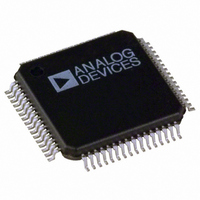AD9238BSTRL-20 Analog Devices Inc, AD9238BSTRL-20 Datasheet - Page 18

AD9238BSTRL-20
Manufacturer Part Number
AD9238BSTRL-20
Description
IC ADC 12BIT DUAL 20MSPS 64-LQFP
Manufacturer
Analog Devices Inc
Datasheet
1.AD9238BSTZ-40.pdf
(48 pages)
Specifications of AD9238BSTRL-20
Rohs Status
RoHS non-compliant
Number Of Bits
12
Sampling Rate (per Second)
20M
Data Interface
Parallel
Number Of Converters
2
Power Dissipation (max)
180mW
Voltage Supply Source
Single Supply
Operating Temperature
-40°C ~ 85°C
Mounting Type
Surface Mount
Package / Case
64-LQFP
AD9238
POWER DISSIPATION AND STANDBY MODE
The power dissipated by the AD9238 is proportional to its
sampling rates. The digital (DRVDD) power dissipation is
determined primarily by the strength of the digital drivers and
the load on each output bit. The digital drive current can be
calculated by
where N is the number of bits changing, and C
load on the digital pins that changed.
The analog circuitry is optimally biased so that each speed
grade provides excellent performance while affording reduced
power consumption. Each speed grade dissipates a baseline
power at low sample rates that increases with clock frequency.
Either channel of the AD9238 can be placed into standby mode
independently by asserting the PDWN_A or PDWN_B pins.
It is recommended that the input clock(s) and analog input(s)
remain static during either independent or total standby, which
results in a typical power consumption of 1 mW for the ADC.
Note that if DCS is enabled, it is mandatory to disable the clock
of an independently powered-down channel. Otherwise,
significant distortion results on the active channel. If the clock
inputs remain active while in total standby mode, typical power
dissipation of 12 mW results.
The minimum standby power is achieved when both channels
are placed into full power-down mode (PDWN_A = PDWN_B =
HI). Under this condition, the internal references are powered
down. When either or both of the channel paths are enabled after a
power-down, the wake-up time is directly related to the recharging
of the REFT and REFB decoupling capacitors and to the duration
of the power-down. Typically, it takes approximately 5 ms to
restore full operation with fully discharged 0.1 μF and 10 μF
decoupling capacitors on REFT and REFB.
I
DRVDD
= V
A
B
–1
–1
DRVDD
Figure 34. Multiplexed Data Format Using the Channel A Output and the Same Clock Tied to CLK_A, CLK_B, and MUX_SELECT
B
× C
–8
A
B
t
PD
0
0
LOAD
A
–7
× f
B
CLOCK
–7
A
B
1
1
A
× N
–6
B
–6
A
B
2
2
A
LOAD
–5
t
PD
is the average
B
–5
A
B
3
3
A
–4
Rev. C | Page 18 of 48
B
–4
A
B
4
4
A
–3
B
–3
A single channel can be powered down for moderate power
savings. The powered-down channel shuts down internal
circuits, but both the reference buffers and shared reference
remain powered on. Because the buffer and voltage reference
remain powered on, the wake-up time is reduced to several
clock cycles.
DIGITAL OUTPUTS
The AD9238 output drivers can be configured to interface with
2.5 V or 3.3 V logic families by matching DRVDD to the digital
supply of the interfaced logic. The output drivers are sized to
provide sufficient output current to drive a wide variety of logic
families. However, large drive currents tend to cause current
glitches on the supplies that may affect converter performance.
Applications requiring the ADC to drive large capacitive loads
or large fanouts may require external buffers or latches.
The data format can be selected for either offset binary or twos
complement. See the Data Format section for more information.
TIMING
The AD9238 provides latched data outputs with a pipeline delay
of seven clock cycles. Data outputs are available one propa-
gation delay (t
to Figure 2 for a detailed timing diagram.
The internal duty cycle stabilizer can be enabled on the AD9238
using the DCS pin. This provides a stable 50% duty cycle to
internal circuits.
The length of the output data lines and loads placed on them
should be minimized to reduce transients within the AD9238.
These transients can detract from the converter’s dynamic
performance. The lowest typical conversion rate of the AD9238
is 1 MSPS. At clock rates below 1 MSPS, dynamic performance
may degrade.
A
B
5
5
A
–2
B
–2
A
B
6
6
A
PD
–1
) after the rising edge of the clock signal. Refer
B
–1
A
B
7
7
A
0
B
0
A
B
8
8
A
1
ANALOG INPUT
ADC A
ANALOG INPUT
ADC B
CLK_A = CLK_B =
MUX_SELECT
D0_A TO
D11_A














